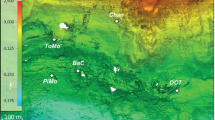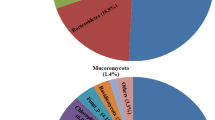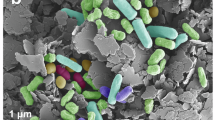Abstract
Microbial community composition and diversity change along chemical gradients, leading to the expectation that microbial community information might provide new gradient characterizations. Here we examine stream bacteria composition and diversity along a strong chemical gradient in Central Appalachian streams. Coal mining in the region generates alkaline mine drainage (AlkMD), causing dramatic increases in conductivity, alkalinity, sulfate and metals sufficient to degrade stream macrobiota communities throughout the ecoregion. In this study, we examined the relationship between water and biofilm chemistry and biofilm bacteria taxonomic composition in streams where active and reclaimed surface coal mines occupied 0–96% of watershed surface area. We incubated wood veneers in each stream site for 4 months to develop biofilms on similar substrates. We sampled water chemistry at the time of deployment and collection, and after 1 month. Following incubation, we collected biofilms for microbial and chemical characterization. Microbial composition was determined by pyrosequencing 16S rRNA amplicons. Biofilm subsamples were analyzed by inductively coupled plasma mass spectrometry to determine metal concentrations. Our results show that microbial community composition differed significantly between AlkMD-exposed and AlkMD-unexposed sites, and that compositional dissimilarity increased with AlkMD loading. Diversity was not correlated with pH or extent of upstream mining, but instead correlated with biofilm concentrations of Cd, Mn, Zn and Ni. Within mined sites, the extent of upstream mining was negatively correlated with taxonomic richness. Despite major compositional shifts, functional capacity predicted with PICRUSt (Phylogenetic Investigation of Communities by Reconstruction of Unobserved States) correlated with mining in only 3 of 43 level-2 KEGG (Kyoto Encyclopedia of Genes and Genomes) Orthology groups.
Similar content being viewed by others
Log in or create a free account to read this content
Gain free access to this article, as well as selected content from this journal and more on nature.com
or
References
Anderson MJ . (2001). A new method for non-parametric multivariate analysis of variance. Austral Ecol 26: 32–46.
Anderson MJ, Willis TJ . (2003). Canonical analysis of principal coordinates: a useful method of constrained ordination for ecology. Ecology 84: 511–525.
Auguet J-C, Barberan A, Casamayor EO . (2010). Global ecological patterns in uncultured Archaea. ISME J 4: 182–190.
Baker BJ, Banfield JF . (2003). Microbial communities in acid mine drainage. FEMS Microbiol Ecol 44: 139–152.
Barbour MT, Gerritsen J, Snyder BD, Stribling JB . (1999). Rapid Bioassessment Protocols for Use in Streams and Wadeable Rivers: Periphyton, Benthic Macroinvertebrates, and Fish, Second Edition. EPA 841-B-99-002. U.S. Environmental Protection Agency, Office of Water: Washington, D.C.
Bates ST, Berg-Lyons D, Caporaso JG, Walters WA, Knight R, Fierer N . (2011). Examining the global distribution of dominant archaeal populations in soil. ISME J 5: 908–917.
Beevers KR . (2006) Sampling Strategies for Particle Filtering SLAM. Troy, NY.
Bernhardt ES, Lutz BD, King RS, Fay JP, Carter CE, Helton AM et al. (2012). How many mountains can we mine? Assessing the regional degradation of Central Appalachian rivers by surface coal mining. Environ Sci Technol 46: 8115–8122.
Bernhardt ES, Palmer MA . (2011). The environmental costs of mountaintop mining valley fill operations for aquatic ecosystems of the Central Appalachians. Ann NY Acad Sci 1223: 39–57.
Bouskill NJ, Barker-Finkel J, Galloway TS, Handy RD, Ford TE . (2010). Temporal bacterial diversity associated with metal-contaminated river sediments. Ecotoxicology 19: 317–328.
Bray JR, Curtis JT . (1957). An ordination of the upland forest communities of Southern Wisconsin. Ecol Monogr 27: 325–349.
Caporaso JG, Kuczynski J, Stombaugh J, Bittinger K, Bushman FD, Costello EK et al. (2010). QIIME allows analysis of high- throughput community sequencing data. Nat Methods 7: 335–336.
Chao A . (1984). Nonparametric estimation of the number of classes in a population. Scand J Stat 11: 265–270.
Chen J, Bittinger K, Charlson ES, Hoffmann C, Lewis J, Wu GD et al. (2012). Associating microbiome composition with environmental covariates using generalized UniFrac distances. Bioinformatics 28: 2106–2113.
De Beer D, Stoodley P . (2006). Microbial biofilms. In Dworkin M, Falkow S, Rosenberg E, Schleifer K-H, Stackebrandt E (eds) SIAM Review vol. 52. Springer: New York, pp 904–937.
De Cáceres M, Legendre P . (2009). Associations between species and groups of sites: indices and statistical inference. Ecology 90: 3566–3574.
De Cáceres M, Legendre P, Moretti M . (2010). Improving indicator species analysis by combining groups of sites. Oikos 119: 1674–1684.
Dufrene M, Legendre P . (1997). Species assemblages and indicator species: the need for a flexible asymmetrical approach. Ecol Monogr 67: 345–366.
Edgar RC . (2010). Search and clustering orders of magnitude faster than BLAST. Bioinformatics 26: 2460–2461.
Feris K, Ramsey P, Frazar C, Moore JN, Gannon JE, Holben WE . (2003). Differences in hyporheic-zone microbial community structure along a heavy-metal contamination gradient. Appl Environ Microbiol 69: 5563–5573.
Feris KP, Ramsey PW, Gibbons SM, Frazar C, Rillig MC, Moore JN et al. (2009). Hyporheic microbial community development is a sensitive indicator of metal contamination. Environ Sci Technol 43: 6158–6163.
Fierer N, Jackson RB . (2006). The diversity and biogeography of soil bacterial communities. Proc Natl Acad Sci USA 103: 626–631.
Fierer N, Morse JL, Berthrong ST, Bernhardt ES, Jackson RB . (2007). Environmental controls on the landscape-scale biogeography of stream bacterial communities. Ecology 88: 2162–2173.
Fortunato CS, Eiler A, Herfort L, Needoba JA, Peterson TD, Crump BC . (2013). Determining indicator taxa across spatial and seasonal gradients in the Columbia River coastal margin. ISME J 7: 1899–1911.
Ganguly S, Jana BB . (2002). Cadmium induced adaptive responses of certain biogeochemical cycling bacteria in an aquatic system. Water Res 36: 1667–1676.
Garrity G . (2005). The Proteobacteria. In Garrity G, Brenner DJ, Krieg NR, Staley JR (eds) Bergey’s Manual of Systematic Bacteriology. Springer: New York, pp 1106.
Giller KE, Witter E, McGrath SP . (2009). Heavy metals and soil microbes. Soil Biol Biochem 41: 2031–2037.
Griffith MB, Norton SB, Alexander LC, Pollard AI, LeDuc SD . (2012). The effects of mountaintop mines and valley fills on the physicochemical quality of stream ecosystems in the central Appalachians: a review. Sci Total Environ 417-418: 1–12.
Griffiths RI, Thomson BC, James P, Bell T, Bailey M, Whiteley AS . (2011). The bacterial biogeography of British soils. Environ Microbiol 13: 1642–1654.
Hering D, Buffagni A, Moog O, Sandin L, Sommerhauser M, Stubauer I et al. (2003). The development of a system to assess the ecological quality of streams based on Macroinvertebrates – design of the sampling programme within the AQEM project. Int Rev Hydrobiol 88: 345–361.
Hesselsoe M, Füreder S, Schloter M, Bodrossy L, Iversen N, Roslev P et al. (2009). Isotope array analysis of Rhodocyclales uncovers functional redundancy and versatility in an activated sludge. ISME J 3: 1349–1364.
Kalyuhznaya MG, Martens-Habbena W, Wang T, Hackett M, Stolyar SM, Stahl DA et al. (2009). Methylophilaceae link methanol oxidation to denitrification in freshwater lake sediment as suggested by stable isotope probing and pure culture analysis. Environ Microbiol Rep 1: 385–392.
Kirby CS, Cravotta CA . (2005). Net alkalinity and net acidity 2: practical considerations. Appl Geochem 20: 1941–1964.
Kuang J-L, Huang L-N, Chen L-X, Hua Z-S, Li S-J, Hu M et al. (2013). Contemporary environmental variation determines microbial diversity patterns in acid mine drainage. ISME J 7: 1038–1050.
Kuczynski J, Liu Z, Lozupone C, Mcdonald D, Fierer N, Knight R . (2010). Microbial community resemblance methods differ in their ability to detect biologically relevant patterns. Nat Methods 7: 813–819.
Lami R, Jones LC, Cottrell MT, Lafferty BJ, Ginder-Vogel M, Sparks DL et al. (2013). Arsenite modifies structure of soil microbial communities and arsenite oxidization potential. FEMS Microbiol Ecol 84: 270–279.
Langille MGI, Zaneveld J, Caporaso JG, McDonald D, Knights D, Reyes JA et al. (2013). Predictive functional profiling of microbial communities using 16S rRNA marker gene sequences. Nat Biotechnol 31: 814–821.
Lauber CL, Hamady M, Knight R, Fierer N . (2009). Pyrosequencing-based assessment of soil pH as a predictor of soil bacterial community structure at the continental scale. Appl Environ Microbiol 75: 5111–5120.
Lear G, Niyogi D, Harding J, Dong Y, Lewis G . (2009). Biofilm bacterial community structure in streams affected by acid mine drainage. Appl Environ Microbiol 75: 3455–3460.
Lindberg TT, Bernhardt ES, Bier R, Helton AM, Merola RB, Vengosh A et al. (2011). Cumulative impacts of mountaintop mining on an Appalachian watershed. Proc Natl Acad Sci USA 108: 20929–20934.
Logares R, Lindström ES, Langenheder S, Logue JB, Paterson H, Laybourn-Parry J et al. (2012). Biogeography of bacterial communities exposed to progressive long-term environmental change. ISME J 7: 1–12.
Lozupone CA, Hamady M, Kelley ST, Knight R . (2007). Quantitative and qualitative beta diversity measures lead to different insights into factors that structure microbial communities. Appl Environ Microbiol 73: 1576–1585.
Lozupone CA, Knight R . (2007). Global patterns in bacterial diversity. Proc Natl Acad Sci USA 104: 11436–11440.
McCullagh P, Nelder J . (1989) Generalized Linear Models 2nd edn Chapman and Hall/CRC: Boco Raton, pp 511.
McCune B, Mefford MJ . (2011). PC-ORD. Multivariate Analysis of Ecological Data. Gleneden Beach, Oregon, USA: MjM Software.
Meyer F, Paarmann D, D’Souza M, Olson R, Glass EM, Kubal M et al. (2008). The metagenomics RAST server — a public resource for the automatic phylogenetic and functional analysis of metagenomes. BMC Bioinformatics 9: 386.
Niyogi DK, Koren M, Arbuckle CJ, Townsend CR . (2007). Stream communities along a catchment land-use gradient: subsidy-stress responses to pastoral development. Environ Manage 39: 213–225.
Odum EP, Finn JT, Franz EH . (1979). Perturbation theory and the subsidy-stress gradient. Bioscience 29: 349–352.
Paerl HW, Dyble J, Moisander PH, Noble RT, Piehler MF, Pinckney JL et al. (2003). Microbial indicators of aquatic ecosystem change: current applications to eutrophication studies. FEMS Microbiol Ecol 46: 233–246.
Palmer MA, Bernhardt ES, Schlesinger WH, Eshleman KN, Foufoula-Georgiou E, Hendryx MS et al. (2010). Mountaintop mining consequences. Science 327: 148–149.
Pond GJ . (2010). Patterns of Ephemeroptera taxa loss in Appalachian headwater streams (Kentucky, USA). Hydrobiologia 641: 185–201.
Pond GJ . (2012). Biodiversity loss in Appalachian headwater streams (Kentucky, USA): Plecoptera and Trichoptera communities. Hydrobiologia 679: 97–117.
Pond GJ, Passmore ME, Borsuk FA, Reynolds L, Rose CJ . (2008). Downstream effects of mountaintop coal mining: comparing biological conditions using family- and genus-level macroinvertebrate bioassessment tools. J North Am Benthol Soc 27: 717–737.
Rose AW, Cravotta CAI . (1998). Geochemistry of coal mine drainage. In: Brady KBC, Smith MW, Schueck J (eds) Coal Mine Drainage Prediction and Pollution Prevention in Pennsylvania. Pennsylvania Department of Environmental Protection: Harrisburg, PA, pp 1–22.
Rousk J, Bååth E, Brookes PC, Lauber CL, Lozupone C, Caporaso JG et al. (2010). Soil bacterial and fungal communities across a pH gradient in an arable soil. ISME J 4: 1340–1351.
Sabater S, Guasch H, Ricart M, Romaní A, Vidal G, Klünder C et al. (2007). Monitoring the effect of chemicals on biological communities. The biofilm as an interface. Anal Bioanal Chem 387: 1425–1434.
Sims A, Zhang Y, Gajaraj S, Brown PB, Hu Z . (2013). Toward the development of microbial indicators for wetland assessment. Water Res 47: 1711–1725.
Solimini AG, Free G, Donohue I, Irvine K, Pusch M, Rossaro B et al. (2006). Using benthic macroinvertebrates to assess ecological status of lakes current knowledge and way forward to support WFD implementation. Institute for Environment and Sustainability, European Commission.
Sverdrup LE, Linjordet R, Strømman G, Hagen SB, van Gestel CAM, Frostegård S et al. (2006). Functional and community-level soil microbial responses to zinc addition may depend on test system biocomplexity. Chemosphere 65: 1747–1754.
Townsend P, Helmers D, Kingdon C, Mcneil B, Debeurs K, Eshleman K . (2009). Changes in the extent of surface mining and reclamation in the Central Appalachians detected using a 1976–2006 Landsat time series. Remote Sens Environ 113: 62–72.
USEPA. (2011) The Effects of Mountaintop Mines and Valley Fills on Aquatic Ecosystems of the Central Appalachian Coalfields. U.S. Environmental Protection Agency: Washington, DC.
USGS (Variously dated). National field manual for the collection of water-quality data U.S. Geological Survey Techniques of Water-Resources Investigations book 9, chaps. A1-A9, available online at http://pubs.water.usgs.gov/twri9A.
Wakelin SA, Colloff MJ, Kookana RS . (2008). Effect of wastewater treatment plant effluent on microbial function and community structure in the sediment of a freshwater stream with variable seasonal flow. Appl Environ Microbiol 74: 2659–2668.
Wetzel RG . (1983) Limnology 2nd edn Saunders College Publishing: Philadelphia, PA, USA.
Xie X, Liao M, Ma A, Zhang H . (2011). Effects of contamination of single and combined cadmium and mercury on the soil microbial community structural diversity and functional diversity. Chin J Geochem 30: 366–374.
Acknowledgements
We thank Ashley Helton, Ty Lindberg, Brooke Hassett, Anna Fedders, Mariah Arnold and Yu-Ting Liu for research assistance and two anonymous reviewers for comments. We thank the Miller family for sampling location guidance. Funding was provided by Foundation for the Carolinas to Nicholas School of the Environment, Duke University, as an unrestricted gift.
Author information
Authors and Affiliations
Corresponding author
Ethics declarations
Competing interests
The authors declare no conflict of interest.
Additional information
Supplementary Information accompanies this paper on The ISME Journal website
Rights and permissions
About this article
Cite this article
Bier, R., Voss, K. & Bernhardt, E. Bacterial community responses to a gradient of alkaline mountaintop mine drainage in Central Appalachian streams. ISME J 9, 1378–1390 (2015). https://doi.org/10.1038/ismej.2014.222
Received:
Revised:
Accepted:
Published:
Issue date:
DOI: https://doi.org/10.1038/ismej.2014.222
This article is cited by
-
Mine reclamation does not restore leaf processing in low-order streams
Hydrobiologia (2023)
-
Pollution shapes the microbial communities in river water and sediments from the Olifants River catchment, South Africa
Archives of Microbiology (2021)
-
Exploring the allochthonous pollution influence on bacterial community and co-occurrence dynamics of River Ganga water through 16S rRNA-tagged amplicon metagenome
Environmental Science and Pollution Research (2021)
-
How sediment bacterial community shifts along the urban river located in mining city
Environmental Science and Pollution Research (2021)
-
Bacterial community composition and potential pathogens along the Pinheiros River in the southeast of Brazil
Scientific Reports (2020)



